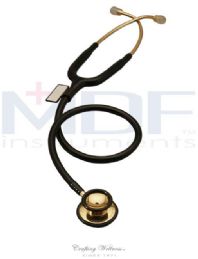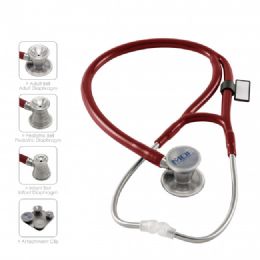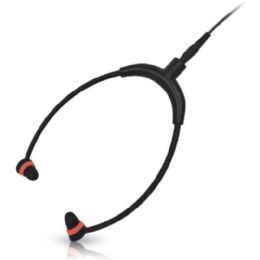
.jpg&newheight=260&quality=80)




















Who uses stethoscopes?
Medical personnel use stethoscopes routinely to listen to sounds produced by the heart, lungs and intestines during routine and emergency medical exams. Stethoscopes are used in conjunction with sphygmomanometers to monitor blood pressure.
They are an invaluable tool in the detection and diagnosis of cardiovascular irregularities such as calcification of the mitral valve, heart murmurs which indicate valve prolapses or issues with blood flow between the heart chambers. Stethoscopes additionally monitor breath sounds that indicate pulmonary diseases such as pneumonia, pulmonary hypertension or tuberculosis.
Stethoscopes may be used on patients of any age and come in appropriate sizes for newborns through adults.
How do stethoscopes work?
The clinician puts the ear pieces in his or her ears, ensuring that they point forward to create an airtight seal to block out ambient noise and that the sound is directed to his or her eardrums by way of the ear canal. It is also important to make sure that the ear tips fit properly and are free of ear wax, dust or lint. The clinician then places the chest piece on the patient’s chest, back and upper arm for blood pressure checks and carotid artery flow, or on the abdomen for fetal heart monitoring or bowel sounds.
On models with flat chest pieces, a membrane acts like an eardrum, registering the sound waves from the heartbeat, blood flow or bowel sound. The bell-shaped chest pieces concentrate the sound. Both transmit the sounds through the attached tubing to the ears of the clinician.
Models with flat pieces detect higher sounds while designs with bell-shaped pieces detect lower ones. Several models feature chest pieces which are flat on one side and bell-shaped on the other. Some may be used to detect pulse rhythms and sounds to monitor blood flow to the extremities in addition to the sounds made by the internal organs.
Features may include electronic amplifiers, a display to visually pinpoint the location of unusual rhythms, and Bluetooth or other means to transfer data to a computer. Some are enabled to work in conjunction with hearing aids.
Where are stethoscopes used?
As one of the most recognizable pieces of medical equipment, stethoscopes are used in medical offices, hospitals, long term care facilities such as nursing homes and private residences where a resident requires blood pressure monitoring. EMTs and personnel at military or NGO medical facilities utilize stethoscopes as part of the initial assessment of a patient’s vital signs.
Hulet Smith, OT
Rehabmart Co-Founder & CEO
fj